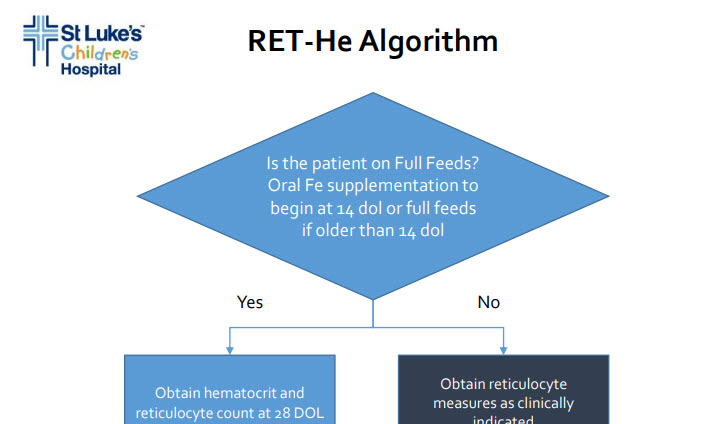CLINICAL GUIDELINES |
Heme
Purpose:
A simple algorithm to assess iron status of the premature infant using the reticulocyte hemoglobin level commonly provided when obtaining a routine CBC.
A RET-He of 27-38 pg/cell indicates iron sufficiency.

The algorithm was developed with evidence-based principles, multi-disciplinary collaboration, and an individualized approach to caring for the neonate.
Population:
Premature infants
Purpose:
A simple algorithm to assess iron status of the premature infant using the reticulocyte hemoglobin level commonly provided when obtaining a routine CBC.
A RET-He of 27-38 pg/cell indicates iron sufficiency.
The algorithm was developed with evidence-based principles, multi-disciplinary collaboration, and an individualized approach to caring for the neonate.
Population: Premature infants



St. Luke’s Children’s Hospital, 190 E Bannock St. Boise, ID 83712
Tammy Allen, NNP, allenta@slhs.org

Dedicated to providing a single-source home for resources on career planning, practice development, and clinical guidelines for neonatologists.
Copyright 2024 © Neonatology Solutions, LLC. All rights reserved.
Disclaimer: All content above is solely the work product of the authors. Neonatology Solutions, LLC, makes no endorsement or statement of safety, efficacy, or appropriateness of any of the protocols, pathways, guidelines, or algorithms contained within. They should be thoroughly reviewed against any available evidence prior to adoption. This content is for informational purposes only and should not be construed or relied upon as a standard of care. Any questions or concerns should be directed to the authors and/or the listed contact person. Good clinical judgement should always prevail when applying any standardized approach. We recommend that institutions review these protocols, pathways, guidelines, and algorithms and accept, modify, or reject them based on their own institutional resources and patient populations. Neonatology Solutions, LLC, assumes no liability for any outcomes arising from use of these tools.
Disclaimer: All content above is solely the work product of the authors. Neonatology Solutions, LLC, makes no endorsement or statement of safety, efficacy, or appropriateness of any of the protocols, pathways, guidelines, or algorithms contained within. They should be thoroughly reviewed against any available evidence prior to adoption. This content is for informational purposes only and should not be construed or relied upon as a standard of care. Any questions or concerns should be directed to the authors and/or the listed contact person. Good clinical judgement should always prevail when applying any standardized approach. We recommend that institutions review these protocols, pathways, guidelines, and algorithms and accept, modify, or reject them based on their own institutional resources and patient populations. Neonatology Solutions, LLC, assumes no liability for any outcomes arising from use of these tools.